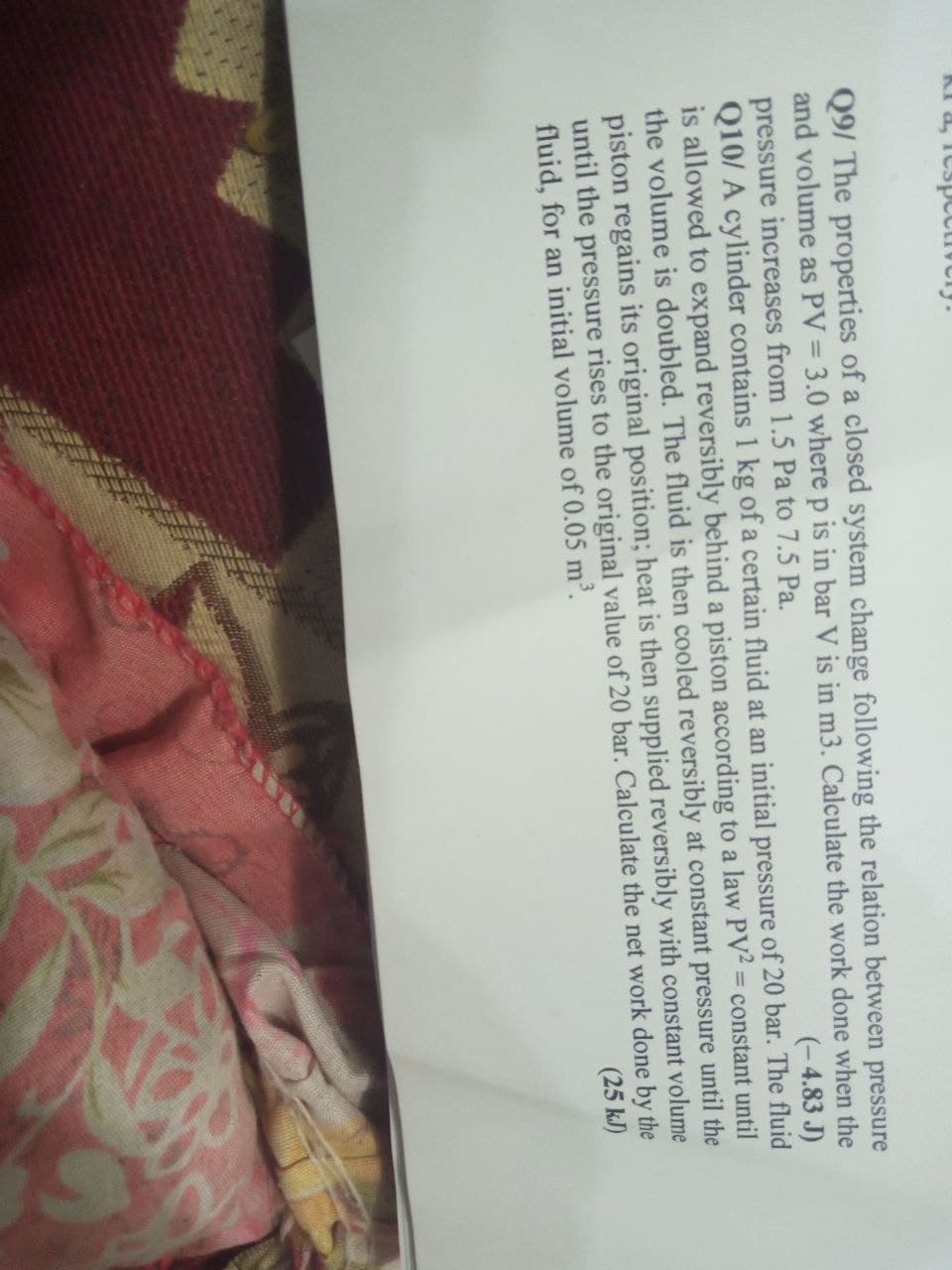Q9/ The properties of a closed system change following the relation between pressure and volume as PV = 3.0 where p is in bar V is in m3. Calculate the work done when the (- 4.83 J) A cylinder contains 1 kg of a certain fluid at an initial pressure of 20 bar. The fluid law PV? = constant until pressure increases from 1.5 Pa to 7.5 Pa.
Q9/ The properties of a closed system change following the relation between pressure and volume as PV = 3.0 where p is in bar V is in m3. Calculate the work done when the (- 4.83 J) A cylinder contains 1 kg of a certain fluid at an initial pressure of 20 bar. The fluid law PV? = constant until pressure increases from 1.5 Pa to 7.5 Pa.
Elements Of Electromagnetics
7th Edition
ISBN:9780190698614
Author:Sadiku, Matthew N. O.
Publisher:Sadiku, Matthew N. O.
ChapterMA: Math Assessment
Section: Chapter Questions
Problem 1.1MA
Related questions
Question

Transcribed Image Text:Ki a, ICspCctivcry.
Q9/ The properties of a closed system change following the relation between pressure
and volume as PV = 3.0 where p is in bar V is in m3. Calculate the work done when the
pressure increases from 1.5 Pa to 7.5 Pa.
Q10/ A cylinder contains 1 kg of a certain fluid at an initial pressure of 20 bar. The fluid
is allowed to expand reversibly behind a piston according to a law PV2 = constant until
the volume is doubled. The fluid is then cooled reversibly at constant pressure until the
piston regains its original position; heat is then supplied reversibly with constant volume
until the pressure rises to the original value of 20 bar. Calculate the net work done by the
fluid, for an initial volume of 0.05 m2.
(-4.83 J)
(25 kJ)
Expert Solution
This question has been solved!
Explore an expertly crafted, step-by-step solution for a thorough understanding of key concepts.
Step by step
Solved in 3 steps with 2 images

Knowledge Booster
Learn more about
Need a deep-dive on the concept behind this application? Look no further. Learn more about this topic, mechanical-engineering and related others by exploring similar questions and additional content below.Recommended textbooks for you

Elements Of Electromagnetics
Mechanical Engineering
ISBN:
9780190698614
Author:
Sadiku, Matthew N. O.
Publisher:
Oxford University Press

Mechanics of Materials (10th Edition)
Mechanical Engineering
ISBN:
9780134319650
Author:
Russell C. Hibbeler
Publisher:
PEARSON

Thermodynamics: An Engineering Approach
Mechanical Engineering
ISBN:
9781259822674
Author:
Yunus A. Cengel Dr., Michael A. Boles
Publisher:
McGraw-Hill Education

Elements Of Electromagnetics
Mechanical Engineering
ISBN:
9780190698614
Author:
Sadiku, Matthew N. O.
Publisher:
Oxford University Press

Mechanics of Materials (10th Edition)
Mechanical Engineering
ISBN:
9780134319650
Author:
Russell C. Hibbeler
Publisher:
PEARSON

Thermodynamics: An Engineering Approach
Mechanical Engineering
ISBN:
9781259822674
Author:
Yunus A. Cengel Dr., Michael A. Boles
Publisher:
McGraw-Hill Education

Control Systems Engineering
Mechanical Engineering
ISBN:
9781118170519
Author:
Norman S. Nise
Publisher:
WILEY

Mechanics of Materials (MindTap Course List)
Mechanical Engineering
ISBN:
9781337093347
Author:
Barry J. Goodno, James M. Gere
Publisher:
Cengage Learning

Engineering Mechanics: Statics
Mechanical Engineering
ISBN:
9781118807330
Author:
James L. Meriam, L. G. Kraige, J. N. Bolton
Publisher:
WILEY